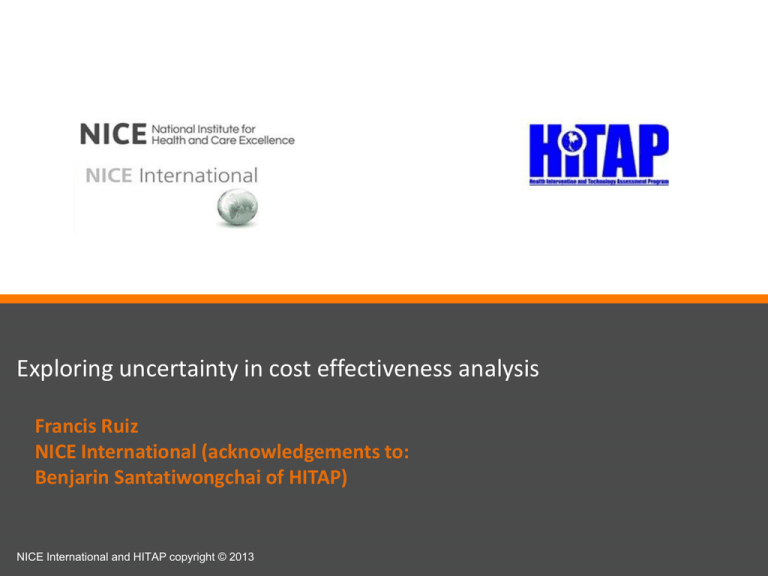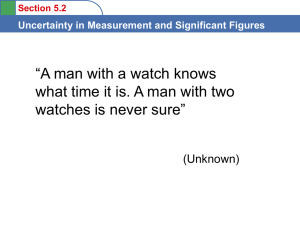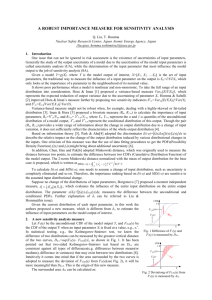
Exploring uncertainty in cost effectiveness analysis
Francis Ruiz
NICE International (acknowledgements to:
Benjarin Santatiwongchai of HITAP)
NICE International and HITAP copyright © 2013
Why uncertainty is important for
decisions?
• All decisions are associated with a risk that a
more optimal course of action could have been
achieved
• All economic evaluations contain uncertainty
• Characterising uncertainty will enable decision
makers to have the option of an informed choice
to reduce uncertainty, e.g. delaying
implementation
2
Reasons for uncertainty over cost
effectiveness results
• Uncertainty over treatment effects
– confidence intervals around estimates from trials/meta-analysis
– uncertainty due to queries over internal/external validity of trials?
• Uncertainty over other data inputs
– baseline risks, costs, utilities,...
– may be quantitative estimates of sampling error (CIs)
– but may also need to estimate ranges more informally
• Assumptions and model structure
– cannot be represented as confidence interval
– may test impact of changing assumptions in sensitivity analysis
Uncertainty versus variability
• Variability (“first-order” uncertainty)
– Natural variation among individuals in their response to treatment
and the costs they incur
– Reflected in standard deviations in a mean value
– Further evidence will not reduce this variation
– NOTE heterogeneity – differences between patients that can (in
part) be explained, e.g. age, sex
• Uncertainty
– Cannot know for certain what the expected (mean) costs and
effects of a particular treatment will be when provided for a given
population
– Further evidence can reduce this uncertainty providing more
precise estimates of these mean costs and health effects (e.g.
bigger studies with reduce CI and SE for estimated parameters)
Type of uncertainty
• Methodological uncertainty
– Methodological disagreement among analysts e.g. rate of discounting,
method for costing
• Modelling uncertainty
– The uncertainty due to the model ‘structure’ relating to the function form
of the model
• Parameter uncertainty
– The uncertainty in parameter inputs to a study that includes sampling
variation
• Generalizability/Transferability
– Using economic evaluation results conducted in one setting in other
settings
5
“Methodological uncertainty” – the role
of the ‘Reference Case’
• Debate about the most appropriate methods to use for some aspects of
health technology assessment.
• Can relate to choices that are essentially value judgements; for example,
whose preferences to use for valuation of health outcomes.
• It also includes methodological choices that relate to more technical
aspects of an analysis; for example, the most appropriate approach to
measuring health-related quality of life (HRQL).
• A reference case specifies the methods considered by the decision
making body to be the most appropriate for its purpose
• An RF facilitates a consistent approach, but does not necessarily
exclude non-RF analyses, especially if strict adherence to the RF is not
possible.
• Issues – implementing changes over time; disagreement
Handling parameter uncertainty
• Sensitivity analysis: model results that reflect
different possible values for model inputs
• Type of sensitivity analysis
– Deterministic: One-way, multi-way, extreme,
threshold
– Probabilistic
7
One-way sensitivity analysis
• One parameter in the
estimation model is set
to vary across a
reasonable range one at
a time.
• The resulted cost,
effectiveness, and ICER
are determined how
sensitive they are with
respect to the varying
range.
8
Extreme
The cost and effectiveness
of the intervention of
interest are evaluated
given the model
parameters that are based
on the best case vs the
worst case scenarios and
yield the extreme value of
ICER.
9
Threshold
Spiegel et al. Ann Intern Med. 2003; 138: 795-806.
The critical value(s) of a parameter or parameters central to the
decision are identified.
10
Problem with deterministic result
presentation
•
•
•
•
•
Ranges
Interaction
Difficult / complex
Interpretation
Summary statement
11
Probability sensitivity analysis
• Take all parameter uncertainty into
account
• Require a knowledge on mathematical
modelling in programmes such as
Microsoft Excel®
12
Probability Sensitivity Analysis (PSA)
13
Simulation results from probabilistic model
£50,000
Incremental costs
£40,000
£30,000
mean ICER
£20,000
£10,000
£0
-£10,000
-£20,000
-2
-1
0
1
2
Incremental life-years
14
3
4
Uncertainty on the CE plane: using the
decision rule
£50,000
RC=£100,000/LY
RC=£50,000/LY
RC=£/LY
RC=£30,000/LY
I ncr ement al cost s
£40,000
RC=£15,000/LY
£30,000
£20,000
RC=£5,000/LY
£10,000
RC=£0/LY
£0
-£10,000
-£20,000
-2
Source: Briggs A (2004)
-1
0
1
2
I ncrement al life-years
15
3
4
0.05
RC=£0/LY
Source: Briggs A (2004)
16
0.5
RC=£15,000/LY
Source: Briggs A (2004)
17
0.87
RC=£50,000/LY
Source: Briggs A (2004)
18
RC=£/LY
0.92
Source: Briggs A (2004)
19
The need for multiple types of
sensitivity analysis
• PSA is not the only sensitivity analysis that should used
• Model structure and choice of data are also subject to
uncertainty, which should be identified and formally
examined using sensitivity analysis.
• This can be done by re-running analysis using alternative
model assumptions or source of data (e.g. excluding a
study from a meta-analysis) where there's doubt.
• Simple deterministic analysis can also help to validate
models - does it behave as expected?
• Can also help to develop the decision makers
understanding of and confidence in the model.
Generalisability / transferability
• “The extent to which the results of a study, as they apply to a
particular patient population and/or a specific context, hold true
for another population and/or in a different context” –Briggs and
Gray 1999: http://www.hta.ac.uk/fullmono/mon302.pdf
• Clinical effectiveness and cost effectiveness
• Drummond et al 2009
– “Generalisability” – economic evaluations applied with no ‘adjustment’
– “Transferability” – adapted to apply in other settings
• Trial populations; Settings, etc
• Decision makers / analysts may need to consider data from
alternative settings
– How to interpret and use?
Dealing with generalisability/
transferability
•
•
•
Checklists – e.g. include / exclude studies
– Qualitative assessment
Quantitative approaches, e.g.
– Regression analyses (if patient level data available)
– Subgroup analysis
Example: Briggs et al 2006 (cited in Drummond et al 2009)
– Cost-effectiveness of asthma control: an economic appraisal of the
GOAL study
– used data from a multinational trial on baseline risks, relative
treatment effects, utility, and resource use data
– Regression analysis using data from the whole trial to estimate costs
for just for United Kingdom
– Assumed clinical / utility estimates generalisable across jurisdictions
Thankyou!
23










